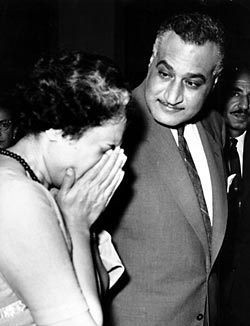Public flogging in Pakistan
Posted in Photo Feature on September 14, 2008 by Barun RoyThe cover of Time Magazine in 1946
Posted in Photo Feature on September 14, 2008 by Barun RoyI am pasting below the entire cover story of the Time magazine of 22 April 1946. It is quite long but informative so you can read it in instalments. There is one error; Jinnah’s father was not a rich man. I see no relevance of the Moslem tiger or the Hindu cow in the text:
By Long Shadow
Monday, Apr. 22, 1946
India’s festering sun beat down impartially on New and Old Delhi-on the precisely geometric, grandly drab preserves of the British Raj, on the noisy, squalid, sprawling native town. A sweat-soaked British wallah might change his shirt four times before settling down to an evening burra peg of bad Australian whiskey in the garden of the Cecil Hotel. Even the calloused, naked feet of shirtless Indians burned as they padded along the teeming Chandni Chauk. In the brassy glare, the flowering trees near the Viceroy’s residence seemed to bear sparks rather than blossoms. The rind of an orange would shrivel the moment it was peeled from its fruit. Here & there an exhausted cow rested, sacred and undisturbed, in the traffic lanes of the boulevards.
Delhi in the spring heat of 1946 was not relaxed; it was taut with waiting, gravid with conflict and suspense. Two Socialist lawyers and a former Baptist lay preacher from Britain had sat for 25 days in the southeast wing of the viceregal palace, preparing to liquidate the richest portion of empire that history had ever seen-to end the British Raj, the grand and guilty edifice built and maintained by William Hawkins and Robert Clive, Warren Hastings and the Marquess Wellesley, the brawling editor James Silk Buckingham and the canny merchant Lord Inchcape, and by the great Viceroys, austere Curzon and gentle Halifax. The Raj was finished: scarcely a voice in Britain spoke against independence; scarcely an Indian wanted the British to stay; scarcely a leader in India questioned the sincerity of Britain’s intention to get out. The only questions were “when?” and “how?”
Last week the three members of the British Cabinet Mission strove to force Indians to take the ultimate step-agreement on the constitution of an independent state. Much like a judge locking a hung jury in an uncomfortable room, Ministers Lord Pethick-Lawrence, A. V. Alexander and Sir Stafford Cripps prepared for a long Easter weekend in Kashmir’s cool mountains with a message that when they returned “they hoped to find sufficient elements of agreement on which a settlement will be based.”
Inside the cream stucco Imperial Hotel, beneath the propeller-blade fans, zealots and schemers argued, intrigued and speculated in more tongues than the Ganges has mouths. When they repeated to each other (as they often did) that now at last Britain’s colonial policy had lumbered to the point where Whitehall really wanted to free India, hope revived. When they reflected (as they often did) that civil war had never been closer, despair reached .its depth. The issue seemed to turn on one man-Mohamed Ali Jinnah. Last week all India watched Jinnah’s words and actions.
Man with an Angora Cap. While the Cabinet Mission still talked with India’s leaders, a meeting was held in the courtyard of Anglo-Arabic College across Delhi from the Viceroy’s palace. Green and white banners flaunted unacademic slogans: “Pakistan or die,” “We are determined to fight.” The speeches were equally inflammatory. Said Abdul Qaiyum Khan from the North-West Frontier Province: “I hope the Moslem nation will strike swiftly before [a Hindu] government can be set up in this country. . . . The Moslems will have no alternative but to take out their swords.” Said Sirdar Shaukat Hyat Khan of the Punjab (which furnishes more than half the troops of the Indian regular army): “The Punjabi Moslems . . . will fight for you unto the death.” Continue reading
Princess Diana dances with John Travolta
Posted in Photo Feature on September 13, 2008 by Barun RoyDirect Action Day, Calcutta 1946 – ‘We shall have India divided or India destroyed’ declares Jinnah
Posted in Photo Feature on September 13, 2008 by Barun RoyThe Shah of Iran wipes his tears in the White House
Posted in Photo Feature on September 13, 2008 by Barun RoyNoor Inayat Khan / Nora Baker (1914-1944) – An exceptional lady with a tragic ending
Posted in Photo Feature on September 13, 2008 by Barun RoyNoor Inayat Khan lived a remarkable life of self sacrifice for the cause of freedom. Brought up in the mystical Sufi tradition, Noor abhored violence but she willingly volunteered for the dangerous task of being a secret agent in occupied France. Incidentally, Noor means “light of womanhood” or “illumination”. She was the great great great granddaughter of the celebrated Muslim ruler of Mysore – Tipu Sultan, who in the 18th Century fought the British, stemming their advance into South India. Her father Inayat Khan did not pursue a political path but instead for brought the great spiritual tradition of Sufi mysticism to the West. He married an American, Ora Meena Ray Baker in Paris and settled in Russia where Noor was born 1 January 1914. After a brief spell of living in England the family relocated to France. Noor was an exceptional person who had an impact on whoever she met. She was described as being “dreamer” and “otherworldly” with a capacity for clairvoyance. On leaving school she studied music for six years, and little by little becoming more European and less oriental in her habits and dress. Her children stories were published in Figaro and a collection of traditional Indian stories, Twenty Jataka Tales, appeared in 1939. She was about to bring out a childrens newspaper in Paris when war broke out. Continue reading








